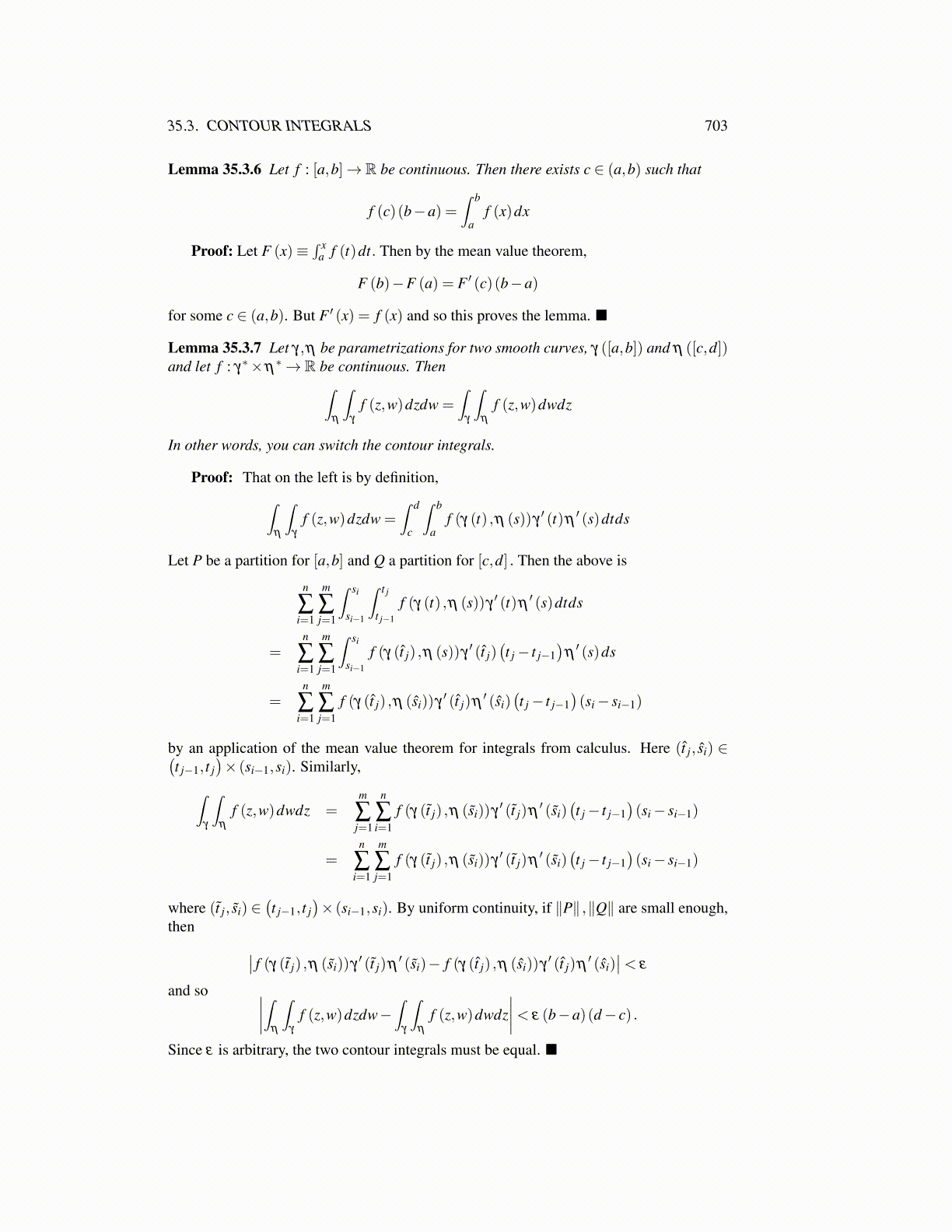
35.3. CONTOUR INTEGRALS 703
Lemma 35.3.6 Let f : [a,b]→ R be continuous. Then there exists c ∈ (a,b) such that
f (c)(b−a) =∫ b
af (x)dx
Proof: Let F (x)≡∫ x
a f (t)dt. Then by the mean value theorem,
F (b)−F (a) = F ′ (c)(b−a)
for some c ∈ (a,b). But F ′ (x) = f (x) and so this proves the lemma. ■
Lemma 35.3.7 Let γ,η be parametrizations for two smooth curves, γ ([a,b]) and η ([c,d])and let f : γ∗×η∗→ R be continuous. Then∫
η
∫γ
f (z,w)dzdw =∫
γ
∫η
f (z,w)dwdz
In other words, you can switch the contour integrals.
Proof: That on the left is by definition,∫η
∫γ
f (z,w)dzdw =∫ d
c
∫ b
af (γ (t) ,η (s))γ
′ (t)η′ (s)dtds
Let P be a partition for [a,b] and Q a partition for [c,d] . Then the above is
n
∑i=1
m
∑j=1
∫ si
si−1
∫ t j
t j−1
f (γ (t) ,η (s))γ′ (t)η
′ (s)dtds
=n
∑i=1
m
∑j=1
∫ si
si−1
f (γ (t̂ j) ,η (s))γ′ (t̂ j)
(t j− t j−1
)η′ (s)ds
=n
∑i=1
m
∑j=1
f (γ (t̂ j) ,η (ŝi))γ′ (t̂ j)η
′ (ŝi)(t j− t j−1
)(si− si−1)
by an application of the mean value theorem for integrals from calculus. Here (t̂ j, ŝi) ∈(t j−1, t j
)× (si−1,si). Similarly,∫
γ
∫η
f (z,w)dwdz =m
∑j=1
n
∑i=1
f (γ (t̃ j) ,η (s̃i))γ′ (t̃ j)η
′ (s̃i)(t j− t j−1
)(si− si−1)
=n
∑i=1
m
∑j=1
f (γ (t̃ j) ,η (s̃i))γ′ (t̃ j)η
′ (s̃i)(t j− t j−1
)(si− si−1)
where (t̃ j, s̃i) ∈(t j−1, t j
)× (si−1,si). By uniform continuity, if ∥P∥ ,∥Q∥ are small enough,
then ∣∣ f (γ (t̃ j) ,η (s̃i))γ′ (t̃ j)η
′ (s̃i)− f (γ (t̂ j) ,η (ŝi))γ′ (t̂ j)η
′ (ŝi)∣∣< ε
and so ∣∣∣∣∫η
∫γ
f (z,w)dzdw−∫
γ
∫η
f (z,w)dwdz∣∣∣∣< ε (b−a)(d− c) .
Since ε is arbitrary, the two contour integrals must be equal. ■